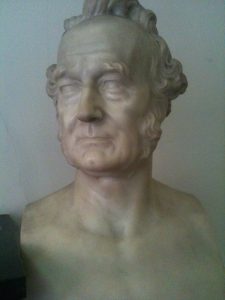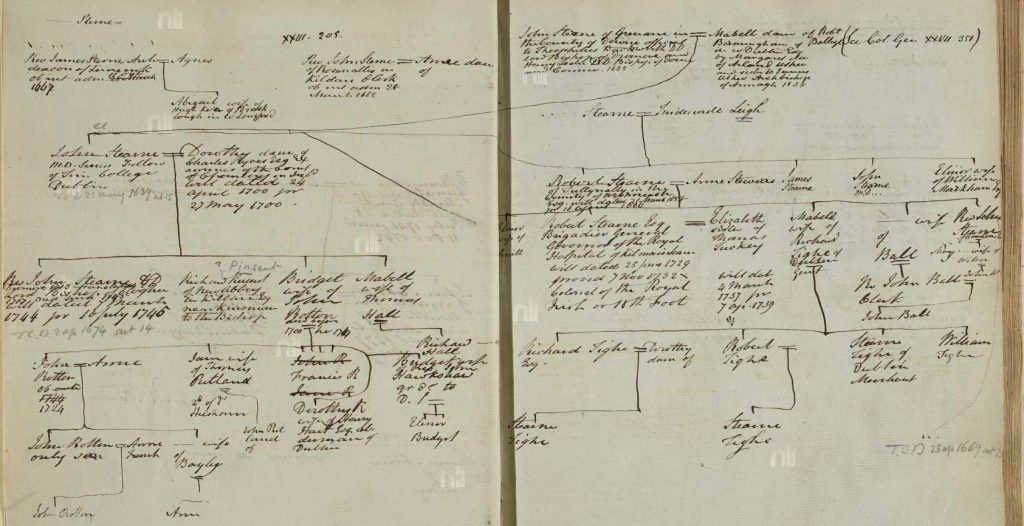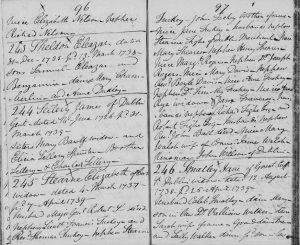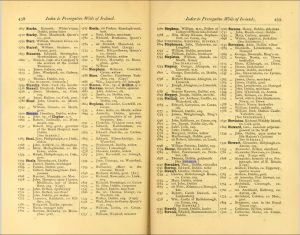
One of my record-keeper heroes has long been Sir William Betham (1779 -1853). He arrived in Dublin for a brief visit in 1805 and by chance found himself wading through the chaotic collections of records held in Dublin Castle. As a result, he went about acquiring authority over the Bermingham Tower records, by getting an appointment as Deputy Ulster King of Arms.
Ulster’s Office was the heraldic authority for the island of Ireland, responsible for providing confirmation of their social status to the Anglo-Irish elite: the right to bear arms was (and is) purely hereditary and thus an indicator of supposed good breeding. So as well as putting order on the Office’s existing records, Betham set about creating a new reference collection covering the propertied Anglo-Irish, the Office’s clientele.
By far the richest source of family information on the propertied Anglo-Irish was the collection of prerogative wills held at the Prerogative Office in Henrietta Street. A prerogative will was one with property worth more than £5 in two probate districts ( Church of Ireland dioceses), meaning they tended to cover the top end of the social scale, the Office’s main market.
In 1807, Betham began to transcribe all the family information recorded in these wills, coming from 1536 right up to 1800. The project took him a full twenty-one years to complete, by which time he had become Ulster King of Arms himself. With the information from the wills, he then created a series of volumes of sketch pedigrees that provided ready-made pigeon-holes for any subsequent information that turned up. These volumes, more than forty in all, are in the Genealogical Office, the successor to Ulster’s Office, now part of the National Library of Ireland and are being digitised superbly through NLI’s online catalogue.


The original notebooks Betham used for the transcriptions were purchased by the National Archives of Ireland in the 1930s and microfilmed by the LDS in 1969. And as part of their program of enhancing online access, those microfilms are now freely available online to signed-in users.

The transcripts are a magnificent source for eighteenth-century Irish ancestors, not only because we blew up all the originals in 1922, but also because the social range covered by the wills is much broader than Betham’s original intentions implied. Shoemakers, ironmongers and small tradesmen of every description are also included. If you lived near a diocesan boundary, it was very easy to have £5-worth of property in more than one diocese.
On the back of the LDS release, FindMyPast have come up with a transcript which I have to say I find a little puzzling. It gives no indication of where the originals are, that the images come from LDS microfilm or that the notebooks are part of a wider set of records. And then lumps the will transcripts in with Marriage Licence Bonds extracts.
But (with a bit of ingenuity) it is possible to use the index to zero in on particular entries in the notebooks, cutting out some of the to-and-froing necessary on FamilySearch. Small mercies.
That’s some work! If I wanted to trace a particular family that I think would be somewhere in there, how would I best go about it?
Sarah
Thank you John for providing some much needed context for these records. It suits Find My Past’s business model very well to keep dumping thousands of records online every Friday but they NEVER provide any proper citations or context. The same problem exists with the Crossle and Thrift records – can you enlighten us on them too please? How are you supposed to be able to do any sort of serious research if you are never given the information to go back to original sources or at least understand how it all fits together with other scant information?!
Ruth, that is unfortunate that FMP dumps stuff and doesn’t properly mention where the original is from. I for one am anxiously waiting for them to dump the sacramental records for the Archdiocese of NY. If they are like the Philadelphia records they will go through 1917 and browsable is fine by me. I have a handful of marriages that I am eager to discover any way possible.
How does one get a copy of one of the wills in the index? I am interested in obtaining a copy of the Will of James Flack dated 1776 on page 172 of the Index to Prerogative Wills of Ireland.
I’m afraid the wills themeselves were all destroyed in 1922. By an explosion of anti-Free State munitions caused by a fire started by Free State army shellfire.
You mentioned the records were blown up in 1922. I’ve known that they were “burnt” for over 30 yrs now, but your choice of words caused an old question to resurface: who did them in & was it an intention of the “vandals” to do in the records or was that incidental?
Also, the destruction (intentional?) of earlier census records – what were they thinking & was it those awful Brits or homegrown twits? (Like our Donald.)
Hi, this is so interesting to read, my introduction to him was via a hand drawing of arms in a family bible and a mention of Sir William Betham, Ulster King of Arms. His daughter married Henry Harding(e) relative of my ancestor. Imagine my surprise in googling what is an Ulster King of Arms to find what he did! Henry is my first cousin, 4 x removed according to my computer. I wonder if his family tree was done ???
A number of the Marriages Licenses codified by Sir John Betham can be cross referenced to https://www.irishgenealogy.ie/en/ and one gets a fuller picture of family makeups…. John
Interesting you mentioned the Crossle records on FMP. I just discoveered them on FMP and realize now that FMP proviced no infrmation regarding how to cite them or from where they come. That is frustrating.
If you look on the findmypast website, you’ll actually find detailed descriptions of all these sources – Betham’s; Crossle; Thrift.
The descriptions describe how the collections were compiled, what you will find in them, and what to look for. There’s loads of excellent research tips too.
Perhaps if you spent a little time online, you might find there aren’t as many problems with the source as this group here seem to think.